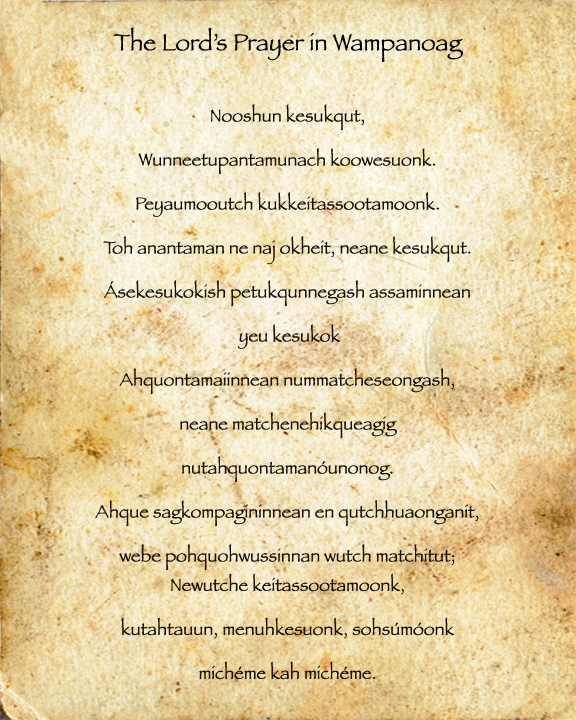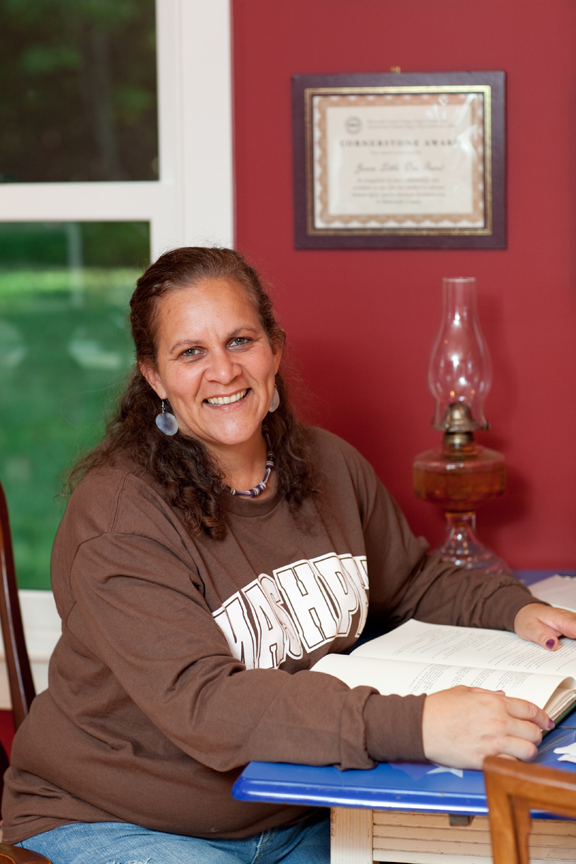
In 1993 Jessie Little Doe Baird began having a series of sacred dreams. In the dreams her ancestors spoke a language she didn’t understand. This language was the Wopânâak language. The Wopânâak language had almost disappeared by the mid-1800s, yet a prophecy told of a time when the language would leave and then come back when the people were ready. It is apparent that Jessie dreams were a message from the ancestors telling the people it was time.
When Jessie started working on the fulfillment of these dreams, the Wampanaog language existed in written form preserved in documents held in museums. There were no fluent speakers to ask about pronunciation, although there were a few in her tribe that knew some words, yet for the most part Jessie had to figure it out on her own.
A very important fact unknown to most people is the Wampanoag were the first Native Americans to have a written form of their language. They understood they had to learn to write in their language in order to create legal documents to protect their land and their rights to whatever degree they could. This in itself speaks of the uniqueness and honor of the Wampanoag people. As a Native person I am in awe of Jessie's ancestors. What extreme efforts it must have taken during such turbulent times when most people were facing basic and immediate survival needs, these ancestors created a path for the future. They left behind many contracts and letters which now are a guide for the reclamation of their language and culture.
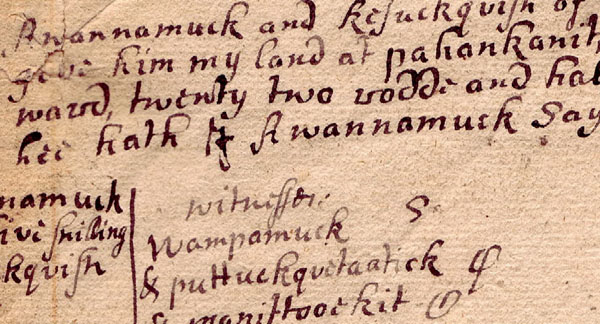
Even though there are vast amounts of written documents, Jessie mentions in the documentary  "We Still Live Here" that one of the words she couldn't find was the word for "dog". Such a simple everyday word, but it was obviously nowhere to be found in legal documents or a bible which had been translated into Wampanoag. Jessie with her unique ability and training was able to convert the word "dog" from a similar Algonquin language changing the phonetics with a formula she had devised. Another tribute to her genius and determination.
"We Still Live Here" that one of the words she couldn't find was the word for "dog". Such a simple everyday word, but it was obviously nowhere to be found in legal documents or a bible which had been translated into Wampanoag. Jessie with her unique ability and training was able to convert the word "dog" from a similar Algonquin language changing the phonetics with a formula she had devised. Another tribute to her genius and determination.
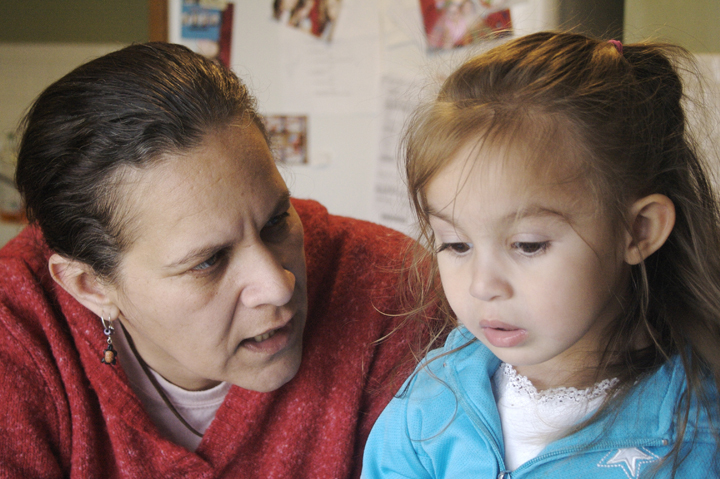
Some of Jessie’s other accomplishments include a Master's degree in linguistics from MIT and the prestigious MacArthur Genius Grant in which Noam Chomsky commented “There is nothing I know of that’s anything like the Wampanaog case” and a Wampanoag dictionary for the people. Yet she speaks of her greatest experience, which is her daughter Mae, the first indigenous speaker in six generations. Again, another encouragement to all indigenous people concerned about the continuation of languages. There is always hope and a possibility.
Another aspect of Jessie's journey was that her primary instructor and helper was a direct descendant of the Rhode Island founder Roger Williams. I do not know Jessie's Wampanoag traditions, but I can say in Lakota traditions it is told to us that the Sacred Hoop will be mended when all four races come together and reconnect the hoop of humanity and the white people are extremely important in the mending of this Hoop. In my personal story, when Lea said she would stand with me on the Thanksgiving project and I later found out she was a direct descendant of a pilgrim family, I felt that this was a step toward mending the Sacred Hoop. I think many times we believe that this mending will be one great big tremendous happening. But in reality the big things happen in tiny steps with individuals. I really resonate with Jessie's journey with Roger Williams. It is important for all of us to realize that it takes the committed effort of all the people to create a better future.
Jessie's path has became full of extraordinary experiences and seemingly impossible victories. The hope and encouragement that her experience has given me is beyond expression. Thank you Jessie for your bravery, honor and victory.
Your relative,
Paula

Links to Wampanaog Language sites
Wôpanâak (Wampanoag) Language Reclamation Project at: http://wlrp.org/
http://wlrp.org/
Our Mother Tongues website at: http://ourmothertongues.org/language/Wampanoag/12
http://ourmothertongues.org/language/Wampanoag/12
A Language Out of Time - Cultural Survival at: http://www.culturalsurvival.org/publications/cultural-survival-quarterly/united-states/language-out-time
http://www.culturalsurvival.org/publications/cultural-survival-quarterly/united-states/language-out-time
MIT Wampanoag Language at:  http://web.mit.edu/norvin/www/wopanaak.html
http://web.mit.edu/norvin/www/wopanaak.html

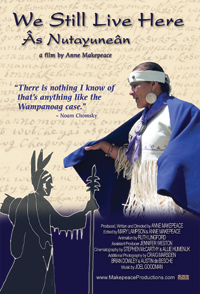
About the film “We Still Live Here”
Anne Makepeace has been a writer, producer, and director of award-winning independent films for more than 20 years. Her films include We Still Live Here - Âs Nutayuneân which won the Full Frame Inspiration Award and the Moving Mountains Prize at Telluride MountainFilm; I.M. Pei: Building China Modern, (PBS/American Masters 2010); Rain in a Dry Land (lead show on P.O.V. 2007) winner of the Full Frame Working Films Award, Emmy nomination; Robert Capa in Love and War, (PBS/American Masters 2003), national Prime Time Emmy Award; Coming to Light(PBS/American Masters 2003), short-listed for an Oscar and winner of many prizes; andBaby It's You (lead show on P.O.V. 1998), Whitney Biennial 2000. Makepeace also wrote the screenplay for Thousand Pieces of Gold and the American Experiencedocumentary Ishi, the Last Yahi.
For additional information please visit  Makepeace Productions.
Makepeace Productions.
You can also view the trailer at PBS.org:
 http://www.pbs.org/independentlens/we-still-live-here/film.html
http://www.pbs.org/independentlens/we-still-live-here/film.html

Please note the following prayer was found on the internet and is not a translation by the Wampanoag Language Reclamation Project.
